Cerithium
Cerithium is a genus of small to medium-sized sea snails, marine gastropod mollusks in the family Cerithiidae, the ceriths.[2]
| Cerithium | |
|---|---|
 | |
| Two views of a shell of Cerithium echinatum, the "spiny creeper" | |
| Scientific classification | |
| Kingdom: | Animalia |
| Phylum: | Mollusca |
| Class: | Gastropoda |
| Clade: | Caenogastropoda |
| Clade: | Sorbeoconcha |
| Superfamily: | Cerithioidea |
| Family: | Cerithiidae |
| Subfamily: | Cerithiinae |
| Genus: | Cerithium Bruguière, 1789[1] |
| Type species | |
| Cerithium adansonii Bruguière, 1792 | |
| Synonyms | |
| |
Species
Species within this genus include:
- Cerithium abditum Houbrick, 1992
- Cerithium adustum Kiener, 1841
- Cerithium africanum Houbrick, 1992
- Cerithium albolineatum Bozzetti, 2008
- Cerithium alucastrum (Brocchi, 1814)
- Cerithium alutaceum (Gould, 1861)
- Cerithium atratum (Born, 1778)
- Cerithium atromarginatum Dautzenberg & Bouge, 1933
- Cerithium balletoni Cecalupo, 2009
- Cerithium balteatum Philippi, 1848
- Cerithium bayeri (Petuch, 2001)
- Cerithium boeticum Pease, 1860
- Cerithium browni (Bartsch, 1928)
- Cerithium buzzurroi Cecalupo, 2005
- Cerithium caeruleum Sowerby, 1855
- † Cerithium calculosum Basterot, 1825
- Cerithium cecalupoi Cossignani, 2004
- Cerithium citrinum Sowerby, 1855
- Cerithium claviforme Schepman, 1907
- Cerithium columna Sowerby, 1834
- Cerithium coralium Kiener, 1841
- Cerithium crassilabrum Krauss, 1848
- Cerithium dialeucum Philippi, 1849
- Cerithium eburneum Bruguière, 1792
- Cerithium echinatum Lamarck, 1842
- Cerithium egenum Gould, 1849
- † Cerithium excavatum Brongniart in Cuvier & Brongniart, 1822
- Cerithium flemischi Martin, 1933
- Cerithium gallapaginis G.B. Sowerby, 1855
- Cerithium gemmatum Hinds, 1844
- Cerithium georgianum Pfeffer, 1886
- Cerithium gloriosum Houbrick, 1992
- Cerithium gracilis Philippi, 1836
- Cerithium guinaicum Philippi, 1849
- Cerithium heteroclites Lamarck, 1822
- Cerithium ianthinum Gould, 1849
- Cerithium interstriatum Sowerby, 1855
- Cerithium ivani Cecalupo, 2008
- Cerithium janthinum (Gould, 1849 in 1846-50) : synonym of Cerithium zebrum Kiener, 1841
- Cerithium kobelti Dunker, 1877 : synonym of Cerithium dialeucum Philippi, 1849
- Cerithium kreukelorum van Gemert, 2012[3]
- Cerithium leptocharactum Rehder, 1980
- Cerithium lifuense Melvill & Standen, 1895
- Cerithium lindae Petuch, 1987
- Cerithium lissum Watson, 1880
- Cerithium litteratum (Born, 1778)
- Cerithium lividulum Risso, 1826
- Cerithium lorenzi Bozzetti, 2020
- Cerithium lutosum Menke, 1828
- Cerithium maculosum Kiener, 1841
- † Cerithium madreporicola Jousseaume, 1931
- Cerithium madreporicola Jousseaume, 1930
- Cerithium mangrovum Q.-M. Sun & S.-P. Zhang, 2014
- Cerithium matukense Watson, 1886
- Cerithium mediolaeve Carpenter, 1857
- Cerithium menkei Carpenter, 1857
- † Cerithium miocanariensis Martín-González & Vera-Peláez, 2018
- Cerithium moniliferum Kiener, 1842 : synonym of Clypeomorus batillariaeformis Habe & Kosuge, 1966
- Cerithium munitum Sowerby, 1855
- Cerithium muscarum Say, 1832
- Cerithium nesioticum Pilsbry & Vanatta, 1906
- Cerithium nicaraguense Pilsbry & Lowe, 1932
- Cerithium nodulosum Bruguière, 1792
- Cerithium novaehollandiae Adams in Sowerby, 1855
- Cerithium ophioderma (Habe, 1968)
- Cerithium pacificum Houbrick, 1992
- Cerithium phoxum Watson, 1880
- Cerithium placidum Gould, 1861
- Cerithium protractum Bivona Ant. in Bivona And., 1838
- Cerithium punctatum Bruguière, 1792
- Cerithium rehderi Houbrick, 1992
- Cerithium renovatum Monterosato, 1884
- Cerithium rostratum Sowerby, 1855
- Cerithium rubus Deshayes, 1843: synonym of Cerithium echinatum Lamarck, 1822
- Cerithium rueppelli Philippi, 1848
- † Cerithium rufonodulosum E. A. Smith, 1901
- Cerithium salebrosum Sowerby, 1855
- Cerithium scabridum Philippi, 1848
- Cerithium scobiniforme Houbrick, 1992
- Cerithium spinosum Philippi, 1836
- Cerithium stercumuscarum Valenciennes, 1833
- Cerithium subscalatum Pilsbry, 1904
- † Cerithium taeniagranulosum Lozouet, 1999 †
- Cerithium tenellum Sowerby, 1855
- Cerithium torresi Smith, 1884
- Cerithium torulosum (Linnaeus, 1767)
- Cerithium traillii Sowerby, 1855
- † Cerithium trochleare Lamarck, 1804
- Cerithium tuberculatum (Linnaeus, 1767)
- Cerithium uncinatum (Gmelin, 1791)
- Cerithium virgatum Montfort, 1810 (nomen dubium)
- Cerithium vulgatum Bruguière, 1792
- Cerithium zebrum (Kiener, 1841)
- Cerithium zonatum (Wood, 1828)
Fossil records
Fossil shells of Cerithium crenatum from Pliocene of Italy
The genus is known from the Triassic to the Recent periods (age range: from 221.5 to 0.0 million years ago). Fossils shells have been found all over the world. There are about 100 extinct species[4][5] including:
- Cerithium crenatum from the Pliocene of Italy
- Cerithium elegans Deshayes, 1824[6]
Gallery
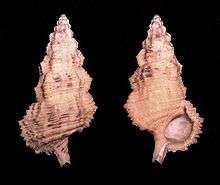
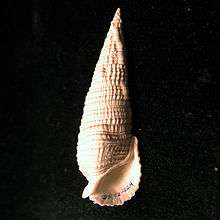 Cerithium dalli
Cerithium dalli

_(4311966772).jpg)
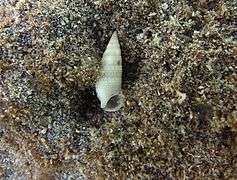
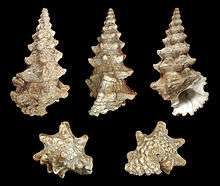
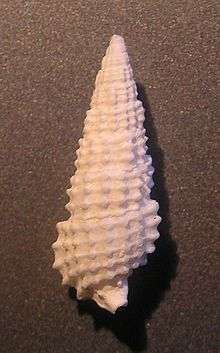

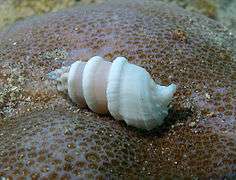
- Cerithium varicosum
gollark: oOyea code in volcano.
gollark: Stupid biomes entirely filled with new releases...
gollark: Probably. Now I need piles of snow, wood and ice.
gollark: Now I'm level 20. This game is clearly designed more with casual players in mind than balance.
gollark: I'm going for "build as many snow cannons as possible".
See also
References
- Bruguière (1789). Ency. Méth. (Vers) 1(2): xv, 546.
- Gofas, S. (2011). Cerithium Bruguière, 1789. Accessed through: World Register of Marine Species at http://www.marinespecies.org/aphia.php?p=taxdetails&id=137760 on 2011-10-07
- van Gemert, L. J. (2012). A new Cerithium from the Philippines (Gastropoda: Cerithiidae). Visaya 3 (5) Archived 2012-11-05 at the Wayback Machine: 11-14.
- Fossilworks
- (in Czech) Pek I., Vašíček Z., Roček Z., Hajn. V. & Mikuláš R.: Základy zoopaleontologie. - Olomouc, 1996. 264 pp., ISBN 80-7067-599-3.
- Cerithium elegans at Museum National d'>Histoire Naturelle, Paris
- OBIS Indo-Pacific Molluscan Database
- A Database of Western Atlantic Marine Mollusca
- Vaught, K.C. (1989). A classification of the living Mollusca. American Malacologists: Melbourne, FL (USA). ISBN 0-915826-22-4. XII, 195 pp
- Houbrick R.S. (1992). Monograph of the genus Cerithium Bruguière in the Indo-Pacific (Cerithiidae: Prosobranchia). Smithsonian contributions to Zoology 510: 1-211
- Petuch E. 2001. New Gastropods named for Frederick M. Bayer, in Recognition of his Contributions to Tropical Western Atlantic Malacology. Bulletin of the Biological Society of Washington 10 : 334-343
- Gofas, S.; Le Renard, J.; Bouchet, P. (2001). Mollusca, in: Costello, M.J. et al. (Ed.) (2001). European register of marine species: a check-list of the marine species in Europe and a bibliography of guides to their identification. Collection Patrimoines Naturels, 50: pp. 180–213
External links
| Wikimedia Commons has media related to Cerithium. |
This article is issued from Wikipedia. The text is licensed under Creative Commons - Attribution - Sharealike. Additional terms may apply for the media files.